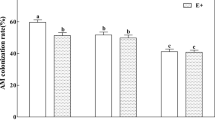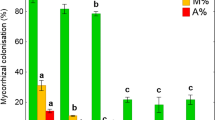Abstract
Our aim was to examine the effect of water stress on plant growth and development of two native plant species (Tetraclinis articulata and Crithmum maritimum) and on microbial community composition and activity in the rhizosphere soil, following the addition of an organic amendment, namely sugar beet residue (SBR), and/or the inoculation with an arbuscular mycorrhizal (AM) fungus, namely Glomus mosseae, in a non-sterile heavy metal-polluted soil. The AM inoculation did not have any significant effect on plant growth of both species. In T. articulata, SBR increased shoot growth, foliar P, total phospholipid fatty acids (PLFA), fungi-related PLFA, AM fungi-related neutral lipid fatty acid, bacterial gram-positive/gram-negative PLFA ratio and the β-glucosidase and dehydrogenase activities. SBR and AM inoculation increased phosphatase activity in T. articulata plants grown under drought conditions. In both plants, there was a synergistic effect between AM inoculation and SBR on mycorrhizal colonisation under drought conditions. In C. maritimum, the increase produced by the SBR on total amounts of PLFA, bacterial gram-positive-related PLFA and bacterial gram-negative-related PLFA was considerably higher under drought conditions. Our results suggest that the effectiveness of the amendment with regard to stimulating microbial communities and plant growth was largely limited by drought, particularly for plant species with a low degree of mycorrhizal colonisation.
Similar content being viewed by others
References
Alguacil MM, Diaz-Pereira E, Caravaca F, Fernández DA, Roldán A (2009) Increased diversity of arbuscular mycorrhizal fungi in a long-term field experiment via application of organic amendments to a semiarid degraded soil. Appl Environ Microbiol 75:4254–4263
Artursson V, Finlay RD, Jansson JK (2006) Interactions between arbuscular mycorrhizal fungi and bacteria and their potential for stimulating plant growth. Environ Microbiol 8:1–10
Augé RM (2001) Water relations, drought and VA mycorrhizal symbiosis. Mycorrhiza 11:3–42
Avidano L, Gamalero E, Paolo Cossa G, Carraro E (2005) Characterization of soil health in an Italian polluted site by using microorganisms as bioindicators. Appl Soil Ecol 30:21–33
Azcón R, Medina A, Roldán A, Biró B, Vivas A (2009) Significance of treated agrowaste residue and autochthonous inoculates (arbuscular mycorrhizal fungi and Bacillus cereus) on bacterial community structure and phytoextraction to remediate soils contaminated with heavy metals. Chemosphere 75:327–334
Caravaca F, Alguacil MM, Figueroa D, Barea JM, Roldán A (2003) Re-establishment of Retama sphaerocarpa as a target species for reclamation of soil physical and biological properties in a semiarid Mediterranean land. Forest Ecol Manag 182:49–58
Carrasco L, Azcón R, Kohler J, Roldán A, Caravaca F (2011) Comparative effects of native filamentous and arbuscular mycorrhizal fungi in the establishment of an autochthonous, leguminous shrub growing in a metal-contaminated soil. Sci Total Environ 409:1205–1209
Carrasco L, Caravaca F, Azcón R, Kohler J, Roldán A (2009) Addition of microbially-treated sugar beet residue and a native bacterium increases structural stability in heavy metal-contaminated Mediterranean soils. Sci Total Environ 407:5448–5454
Carrasco L, Gattinger A, Fließbach A, Roldán A, Schloter M, Caravaca F (2010) Estimation by PLFA of microbial community structure associated with the rhizosphere of Lygeum spartum and Piptatherum miliaceum growing in semiarid mine tailings. Microb Ecol 60:265–271
Ceccanti B, Pezzarossa B, Gallardo-Lancho FJ, Masciandaro G (1994) Bio-tests as markers of soil utilization and fertility. Geomicrobiol J 11:309–316
Doelman P (1985) Resistance of soil microbial communities to heavy metals. In: Jensen V, Kjöller A, Sörensen LH (eds) Microbial communities in soil. Elsevier, London, pp 369–384
Dybczyński R, Polkowska-Motrenko H, Samczyński Z, Szopa Z (1997) Preparation and certification of the Polish reference material “Virginia Tobacco Leaves” (CTA-VTL-2) for inorganic trace analysis including microanalysis, Raporty IChTJ, Seria A, Nr 3/97. Institute of Nuclear Chemistry and Technology, Warsaw
Ellis RJ, Neish B, Trett M, Best JG, Weightman AJ, Morgan P, Fry JC (2001) Comparison of microbial and meiofaunal community analyses for determining impact of heavy metal contamination. J Microbiol Methods 45:171–185
Frostegård Å, Tunlid A, Bååth E (1993) Phospholipid fatty acid composition, biomass, and activity of microbial communities from two soil types experimentally exposed to different heavy metals. Appl Environ Microbiol 59:3605–3617
García C, Hernández MT, Costa F (1997) Potential use of dehydrogenase activity as an index of microbial activity in degraded soils. Comm Soil Sci Plant 28:123–134
Geisseler D, Horwath WR, Scow KM (2011) Soil moisture and plant residue addition interact in their effect on extracellular enzyme activity. Pedobiologia 54:71–78
Giovannetti M, Mosse B (1980) An evaluation of techniques for measuring vesicular arbuscular mycorrhizal infection in roots. New Phytol 84:489–500
Gónzalez-Guerrero M, Benabdellah K, Ferrol N, Azcón-Aguilar C (2009) Mechanisms underlying heavy metal tolerance in arbuscular mycorrhiza. In: Azcón-Aguilar C, Barea JM, Gianinazzi S, Gianinazzi-Pearson V (eds) Mycorrhizas: functional processes and ecological impact. Springer, Heidelberg, pp 107–121
Gryndler M, Sudová R, Püschel D, Rydlová J, Janouková M, Vosátka M (2008) Cultivation of high-biomass crops on coal mine spoil banks: can microbial inoculation compensate for high doses of organic matter? Bioresour Technol 99:6391–6399
Harinikumar KM, Bagyaraj DJ, Mallesha BC (1990) Effect of intercropping and organic soil amendments on native VA mycorrhizal fungi in an oxisol. Arid Soil Res Rehab 4:193–197
Harris J (2009) Soil microbial communities and restoration ecology: facilitators or followers? Science 325:573–574
Jacquot-Plumey E, van Tuinen D, Chatagnier O, Gianinazzi S, Gianinazzi-Pearson V (2001) 25S rDNA-based molecular monitoring of glomalean fungi in sewage sludge-treated field plots. Environ Microbiol 3:525–531
Joner EJ, Jakobsen I (1995) Uptake of 32P from labelled organic matter by mycorrhizal and non-mycorrhizal subterranean clover (Trifolium subterraneum L.). Plant Soil 172:221–227
Joner EJ, Johansen A (2000) Phosphatase activity of external hyphae of two arbuscular mycorrhizal fungi. Mycol Res 104:81–86
Klein DA, Frederick BA, Biondini M, Trlica MJ (1988) Rhizosphere microorganism effects on soluble amino acids, sugars and organic acids in the root zone of Agropyron cristatum. A. smithii, and Bouteloua gracilis. Plant Soil 110:19–25
Labidi S, Nasr H, Zouaghi M, Wallander H (2007) Effects of compost addition on extra-radical growth of arbuscular mycorrhizal fungi in Acacia tortilis ssp. raddiana savanna in a pre-Saharan area. Appl Soil Ecol 35:184–192
Medina A, Jakobsen I, Egsgaard H (2011) Sugar beet waste and its component ferulic acid inhibits external mycelium of arbuscular mycorrhizal fungus. Soil Biol Biochem 43:1456–1463
Medina A, Vassileva M, Barea JM, Azcón R (2006) The growth-enhancement of clover by Aspergillus-treated sugar beet waste and Glomus mosseae inoculation in Zn contaminated soil. Appl Soil Ecol 33:87–98
Nannipieri P (1994) The potential use of soil enzymes as indicators of productivity, sustainability and pollution. In: Pankhurst CE, Doube BM, Gupta VVSR, Grace PR (eds) Soil biota: management in sustainable farming systems. CSIRO, East Melbourne, pp 238–244
Naseby DC, Lynch JM (1997) Rhizosphere soil enzymes as indicators of perturbations caused by enzyme substrate addition and inoculation of a genetically modified strain of Pseudomonas fluorescens on wheat seed. Soil Biol Biochem 29:1353–1362
Olsson PA (1999) Signature fatty acids provide tools for determination of the distribution and interactions of mycorrhizal fungi in soil. FEMS Microbiol Ecol 29:303–310
Phillips JM, Hayman DS (1970) Improved procedures for clearing roots and staining parasitic and vesicular–arbuscular mycorrhizal fungi for rapid assessment of infection. Trans Br Mycol Soc 55:158–161
Roldán A, Díaz-Vivancos P, Hernández JA, Carrasco L, Caravaca F (2008) Superoxide dismutase and total peroxidase activities related to drought-recovery performance of mycorrhizal shrub seedlings grown in an amended semiarid soil. J Plant Physiol 165:715–722
Rousk J, Bååth E (2007) Fungal and bacterial growth in soil with plant materials of different C/N ratios. FEMS Microbiol Ecol 62:350–358
Ryan MH, Chilvers GA, Dumaresq DC (1994) Colonisation of wheat by VA-mycorrhizal fungi was found to be higher on a farm managed in an organic manner than on a conventional neighbour. Plant Soil 160:33–40
Sáinz MJ, Taboada-Castro MT, Vilariño A (1998) Growth, mineral nutrition and mycorrhizal colonization of red clover and cucumber plants grown in a soil amended with composted urban wastes. Plant Soil 205:85–92
Sakamoto K, Oba Y (1994) Effect of fungal to bacterial biomass ratio on the relationship between CO2 evolution and total soil microbial biomass. Biol Fertil Soils 17:39–44
Smith SE, Read DJ (2008) Mycorrhizal symbiosis. Academic, San Diego
Tabatabai MA (1994) Soil enzymes. In: Weaver RW, Angle JS, Bottomley PS (eds) Methods of soil analysis. Part 2. Microbiological and biochemical properties. SSSA Book Series No. 5. Soil Science Society of America, Madison, pp 775–833
Vaidya GS, Shrestha K, Khadge BR, Johnson NC, Wallander H (2008) Organic matter stimulated bacteria and arbuscular mycorrhizal fungi in Bauhinia purpurea and Leucaena diversifolia plantations on eroded slopes in Nepal. Restor Ecol 16:79–87
von Mersi W, Schinner E (1991) An improved and accurate method for determining the dehydrogenase activity of soils with iodonitrotetrazolium chloride. Biol Fertil Soils 11:210–220
Acknowledgements
This research was supported by CICYT (project AGL2009-12530-CO2-01).
Author information
Authors and Affiliations
Corresponding author
Rights and permissions
About this article
Cite this article
Fernández, D.A., Roldán, A., Azcón, R. et al. Effects of Water Stress, Organic Amendment and Mycorrhizal Inoculation on Soil Microbial Community Structure and Activity During the Establishment of Two Heavy Metal-Tolerant Native Plant Species. Microb Ecol 63, 794–803 (2012). https://doi.org/10.1007/s00248-011-9972-y
Received:
Accepted:
Published:
Issue Date:
DOI: https://doi.org/10.1007/s00248-011-9972-y




